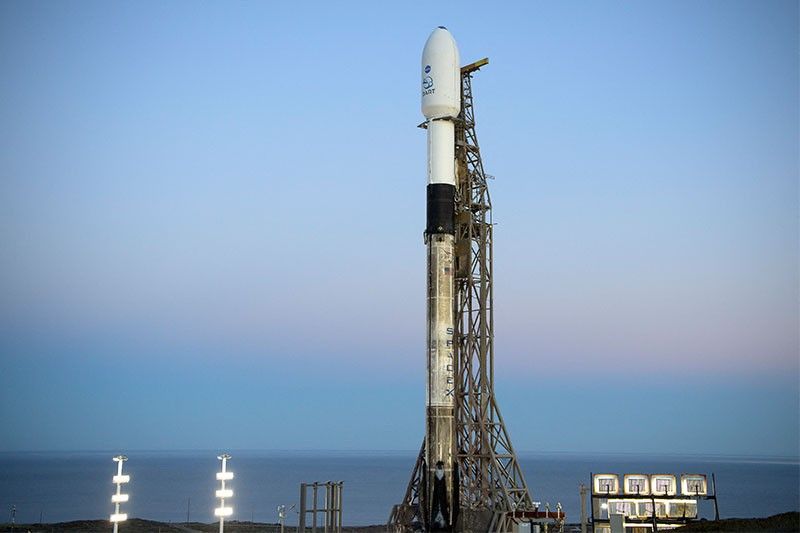NASA launches spacecraft to kick an asteroid off course

WASHINGTON, United States — NASA is preparing a mission to deliberately smash a spacecraft into an asteroid — a test run should humanity ever need to stop a giant space rock from wiping out life on Earth.
It may sound like the stuff of science fiction, but the DART (Double Asteroid Redirection Test) is a real proof-of-concept experiment, blasting off at 10:21 pm Pacific Time Tuesday (0621 GMT Wednesday) aboard a SpaceX rocket from Vandenberg Space Force Base in California.
"All systems and weather are looking good for tonight's Falcon 9 launch," Elon Musk's company tweeted.
The goal is to slightly alter the trajectory of Dimorphos, a "moonlet" around 525 feet (160 meters, or two Statues of Liberty) wide that circles a much larger asteroid called Didymos (2,500 feet in diameter). The pair orbit the Sun together.
Impact should take place in the fall of 2022, when the binary asteroid system is 6.8 million miles (11 million kilometers) from Earth, almost the nearest point they ever get.
"What we're trying to learn is how to deflect a threat," NASA's top scientist Thomas Zuburchen said of the $330 million project, the first of its kind.
To be clear, the asteroids in question pose no threat to our planet.
But they belong to a class of bodies known as Near-Earth Objects (NEOs) — asteroids and comets that approach our planet within 30 million miles.
NASA's Planetary Defense Coordination Office is most interested in those larger than 460 feet in size, which have the potential to level entire cities or regions with many times the energy of average nuclear bombs.
There are 10,000 known near-Earth asteroids 460 feet in size or greater, but none has a significant chance to hit in the next 100 years. One major caveat: only about 40 percent of those asteroids have been found to date.
15,000 mph kick
Planetary scientists can create miniature impacts in labs and use the results to create sophisticated models about how to divert an asteroid — but models are always inferior to real world tests.
Scientists say the Didymos-Dimorphos system is an "ideal natural laboratory," because Earth-based telescopes can easily measure the brightness variation of the pair and judge the time it takes the moonlet to orbit its big brother.
Since the current orbit period is known, the difference will reveal the effect of the impact, scheduled to occur between September 26 and October 1, 2022.
What's more, since the asteroids' orbit never intersects our planet, they are thought safer to study.
The DART probe, which is a box the size of a large fridge with limousine-sized solar panels on either side, will slam into Dimorphos at just over 15,000 miles an hour.
Andy Rivkin, DART investigation team lead, said that the current orbital period is 11 hours and 55 minutes, and the team expects the kick will shave around 10 minutes off that time.
There is some uncertainty about how much energy will be transferred by the impact, because the moonlet's internal composition and porosity are not known.
The more debris that's generated, the more push will be imparted on Dimorphos.
"Every time we show up at an asteroid, we find stuff we don't expect," said Rivkin.
The DART spacecraft also contains sophisticated instruments for navigation and imaging, including the Italian Space Agency's Light Italian CubeSat for Imaging of Asteroids (LICIACube) to watch the crash and its after-effects.
Nuclear blasts
The so-called "kinetic impactor" method isn't the only way to divert an asteroid, but it is the technique that is the most ready with current technology.
Others that have been hypothesized include flying a spacecraft close by to impart a small gravitational force.
Another is detonating a nuclear blast close by — but not on the object itself, as in the films Armageddon and Deep Impact — which would probably create many more perilous objects.
Scientists estimate 460-foot asteroids strike once every 20,000 years.
Asteroids that are six miles or wider — such as the one that struck 66 million years ago and led to the extinction of most life on Earth, including the dinosaurs — occur around every 100-200 million years.
Monitor major developments on space explorations and the status of missions.
NASA reveals a sample collected from the 4.5-billion-year-old asteroid Bennu contains abundant water and carbon, offering more evidence for the theory that life on Earth was seeded from outer space.
The discovery follows a seven-year-round-trip to the distant rock as part of the OSIRIS-REx mission, which dropped off its precious payload in the Utah desert last month for painstaking scientific analysis.
"This is the biggest carbon-rich asteroid sample ever returned to Earth," NASA administrator Bill Nelson says at a press event at the Johnson Space Center in Houston, where the first images of black dust and pebbles were revealed. — AFP
NASA is set to reveal on Wednesday the first images of the largest asteroid sample ever collected in space, something scientists hope will yield clues about the earliest days of our solar system and perhaps the origins of life itself.
The OSIRIS-REx mission collected rock and dust from the asteroid Bennu in 2020, and a capsule containing the precious cargo successfully returned to Earth a little over two weeks ago, landing in the Utah desert.
It is now being painstakingly analyzed in a specialized clean room at NASA's Johnson Space Center in Houston. — AFP
A Spanish company launches the country's first private rocket on Saturday in a step towards bringing Spain into the exclusive club of space-faring nations.
The launch of the small MIURA1 rocket took place at 02:19 am (0019 GMT) from a military base in the southern region of Andalusia, according to the company, PLD Space.
The company hailed the launch as "successful" and said it had achieved all its "technical objectives". — AFP
India's Sun-monitoring spacecraft has crossed a landmark point on its journey to escape "the sphere of Earth's influence", its space agency says, days after the disappointment of its Moon rover failing to awaken.
The Aditya-L1 mission, which started its four-month journey towards the centre of the solar system on September 2, carries instruments to observe the Sun's outermost layers.
"The spacecraft has escaped the sphere of Earth's influence," the Indian Space Research Organisation (ISRO) says in a statement. — AFP
Carbon dioxide detected on Jupiter's moon Europa comes from the vast ocean beneath its icy shell, research using James Webb Space Telescope data, potentially bolstering hopes the hidden water could harbour life.
Scientists are confident there is a huge ocean of saltwater kilometres below Europa's ice-covered surface, making the moon a prime candidate for hosting extra-terrestrial life in our Solar System.
But determining whether this concealed ocean has the right chemical elements to support life has been difficult. — AFP
- Latest






























